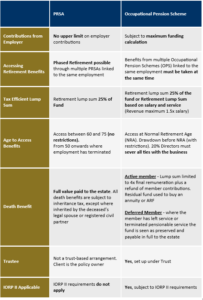From Boss To Beach Bum: How Retirement Planning Can Help You Trade The Swivel Chair For A Sun Lounger
With many companies having aligned their company tax year with the financial year, their end-of-year as at 31st December is fast approaching. Therefore, business owners are presented with a unique opportunity to secure their financial future and provide for their retirement through retirement planning. One of the most effective ways to achieve this is by funding a retirement plan before the company year-end. By taking advantage of the tax benefits and potential growth opportunities associated with pension contributions, business owners can not only secure their own retirement but also enjoy significant advantages in terms of tax savings.
Key Advantages of Company Contributions for Business Owners
- Corporation tax relief at 12.5%.
- No personal Income Tax, PRSI, or USC liability.
- No PRSI liability for the employer/company.
- Opportunity to plan for a business exit strategy with access to funds as early as 50.
- Pension lump sum at retirement, which is tax-free up to the first €200,000 and subject to a favourable rate of 20% for the next €300,000.
- Income in retirement via an Annuity, Vested Personal Retirement Savings Account (PRSA), or Approved Retirement Fund (ARF).
- Possibility to pass wealth to a spouse and children via a Vested PRSA or ARF.
What Type of Retirement Plan?
Well if your destination is a sun lounger, the journey to get there now may be via a PRSA. PRSAs are now at the forefront of retirement planning in Ireland thanks to the Finance Act 2022. The Act’s main pension change was the removal of the (Benefit in Kind) BIK on employer contributions to a PRSA paid after 1 January 2023, and in this regard, employer contributions to a PRSA are no longer deemed to be paid by the employee for Income Tax relief (age-related contribution rules).
So what do the Finance Act 2022 changes mean to you as the business owner/employee under a PRSA?
These were very welcome changes when previously an employer/company contribution made to a traditional occupational pension scheme was restricted based on salary and service, and the employer/company were often required to spread tax relief over a number of years. Now employers can make an unlimited PRSA contribution on behalf of an employee or director, including themselves, provided they are in full-time employment and in receipt of a Schedule E income. There is no minimum salary level required. The company can make the contribution subject to the capacity of the company to fund the contribution and the profits/corresponding tax the company is paying, and the PRSA contribution will be allowed as an expense in the year in which the contribution is paid. The level of contribution made by the company to the PRSA will not affect the level of personal contributions you as an employee can still make to the same PRSA. Finally, employees/directors who are still employed and who have already accessed retirement benefits under the Standard Fund Threshold (SFT) may continue to fund a PRSA to the Standard Fund Threshold (SFT)*.
*The Standard Fund Threshold (SFT) is the maximum pension an individual is allowed at retirement for tax purposes. This is a lifetime limit and includes all pension benefits taken since 7 December 2005. The Standard Fund Threshold is currently €2,000,000. At retirement, any amount over the SFT is subject to income tax at 40%.
For many business owners, the Finance Act 2022 changes are very positive, notably for those on low salaries with little or no scope to fund under an occupational pension scheme and those on larger salaries who have large profits which they want to extract now and obtain tax relief immediately. Another key advantage of the PRSA for some business owners is the more simplistic approach to a death benefit claim as an active member/employee.
How does a PRSA compare with an Occupational Pension Scheme?
By comparing some key differences between an Occupational Pension Scheme and a PRSA product, there are several areas when a PRSA may offer a more suitable means to retirement savings for Business Owners.

Retirement Planning
Source: CFI
Company Succession planning.
For business owners looking at a succession plan, there are three main options to extract profits from their company, in the form of:
- Leaving profits in the company and extracting proceeds through the sale of the company at some future date; or
- Withdrawing profits as salary or dividends; and/or
- Withdrawing profits via a company/employer contribution to a retirement plan.
Funding a retirement plan before selling the company can provide several personal benefits to the business owner. Certainly, for many prospective clients I meet, they often consider their pension fund as a standalone source of retirement income and can sometimes overlook the opportunity to utilise the features of a retirement plan to extract wealth tax-efficiently from their company into a personal asset.
The need for professional retirement advice has never been more important. Cantor Fitzgerald can work with you to review your retirement arrangements and formulate a cohesive retirement and investment strategy. We understand that retirement can mean different things to different people and have a range of pension solutions to suit your individual retirement planning needs. To speak with a Portfolio Manager or Account Executive, phone the Cantor Fitzgerald dealing desk on 01 633 3800.



 Laura Reidy
Laura Reidy